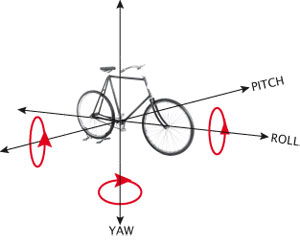
Bicycle Trailers
For many of us, Summer is a season of work. We have yards to landscape, houses to paint, Christmas lights to finally take down. Even our recreation requires work. Camping gear must be packed and hauled, picnics transported, and kayaks moved. But Summer is also an ideal time to ride your bike and there's no better way to combine your love of Summer projects with your love of bicycling, than to hitch up a cargo trailer and get to work.
The magnificent thing about bike trailers is that they completely circumvent the original design intent of your bicycle. This is a good thing because for years, bicycles have been designed as recreational toys rather than practical tools. But the bicycle trailer changes all that and, in fact, can give you the best of both worlds--performance and practicality. Whether you ride a mountain bike or a lightweight road rocket, a bike trailer will let you move your gear with equal aplomb. With a trailer, there's no need for bombproof wheels, stout frames, or Rube-Goldberg load-lashing schemes.
Demystifying the Bike Trailer
No one looks twice anymore at the sight of a child trailer cruising down the block. But drag a few potted plants or bags of topsoil down the road on a flatbed cargo trailer and people look at you as if you were a circus performer. That's because we've been trained to think of bikes as recreation. The advent of the jogging stroller got us used to the idea of the child trailer. Both look sporty and recreational. But a bicycle hauling cargo looks as odd as a logging truck with a "Free Tibet" bumper sticker--it's just not an expected combination. It's time to demystify the act of hauling cargo by bike.
How Much Work Is It, Really?
If you live in a relatively flat place, not much. Towing a bike trailer on flat ground is nearly the same as riding without one. You'll notice the extra weight when accelerating or decelerating, but the bike will handle pretty much the same as it always does.
Hills are another matter. Even though the bike will handle the same as it would without the trailer, you can't escape the fact that dragging more weight uphill is harder than dragging less weight uphill. The answer to this is gearing. Bike Trailer Shop
With enough time and the right gearing, even a small child could tow an elephant up a tall mountain. But even with reasonable amounts of time and standard gearing, most sub-200-pound loads can be easily moved about town. Most mountain bikes come equipped with gears low enough (20 gear-inches) for an average person to haul about 100 pounds up a moderate 6-degree incline with a moderate level of exertion. You'll only be going about 5mph, but it's still faster than walking and a whole lot more fun and healthy than driving. If the grades aren't too steep, you can easily haul as much as 300 pounds around without having to be Lance Armstrong. In fact, after a few trips with a loaded trailer, try going for a ride without the weight... you'll feel like you're Lance when you hit the first big hill. If you must think of bikes in recreational terms, just think of cargo-hauling as a "training opportunity."
Bicycle trailers are misunderstood beasts of burden. There are many choices and choosing the right one can be difficult amidst all the marketing hype. Do you want a one-wheeled trailer or a two-wheeled trailer? A seatpost hitch or an axle hitch? Are larger wheels better than smaller wheels? Or the most common and, unfortunately, too vague to answer, question: which trailer should I get? The best way to answer these questions is to learn about what effect different designs will have on trailer performance, and let you decide which specific product is best for your situation.
One Wheel or Two?
When it comes to cargo trailers you have your choice of single-wheel or two-wheeled trailers. Each has its own advantages and disadvantages and the appropriate choice depends on what you'll be using the trailer for.
If you'll be negotiating narrow trails and generally hauling gear off-road, then a single-wheel trailer is the way to go. Single-wheel trailers attach to the axle of the bike using a special skewer. Because they have only a single centered wheel, they don't hold themselves up and depend on the bike to maintain their angle of roll.
On one hand this is good because it means that the load will lean into corners with the bike, making it very stable through the turn. The disadvantage is that you'll feel that extra weight when you lean the bike at slow speeds. And while single-wheel trailers are very stable through turns, they can become unstable when subjected to transitions between turns. If you have to veer suddenly around a pothole, for instance, the bike and trailer are subjected to a sudden left then right turn. In effect, the extra weight of the rotationally-connected trailer has an inertia to it that resists that transition from left to right. This can be especially pronounced on a bike with long chainstays (like many touring bikes) because the rotational load is transferred to the trailer through the chainstays. Because longer chainstays are more flexible, you end up with a bike/trailer combination that oscillates in scary ways when subjected to rapid side to side motion (like hard, out-of-the-saddle climbing.) Most mountain bikes, however, have short chainstays and stiffer wheels, reducing the problem of oscillation considerably.
Most single-wheel trailers have a maximum capacity of about 50 pounds, much less than that of a two-wheeled trailer. But again, if you ride off-road, especially on single-track trails, the disadvantages of a single-wheel trailer are heavily outweighed by its advantages, most notably in narrowness and maneuverability. Many tourers also like single-wheel trailers because they can be ridden along narrow road shoulders and in between highway rumble strips--things that plague two-wheeled trailers.
Two-wheeled trailers on the other hand are the undisputed kings of the heavy load and models are readily available that are rated for up to 200 pounds. They have higher capacities than single-wheel trailers for a couple of reasons. One, the wheels of a two-wheeled trailer each carry only half the weight. Second, because the load is usually centered between the trailer's axles, and because the trailer is rotationally-decoupled, the bicycle itself carries almost none of weight of a loaded trailer. Compared to most single-wheel designs which transfer almost half the weight to the bicycle itself (the ExtraWheel trailer being a notable exception to this,) two-wheeled trailers rely less on the bicycle itself for stability.
Two-wheeled trailers are rotationally-decoupled from the bike, meaning that as you lean the bike from side to side, the trailer stays parallel to the ground. Because the load doesn't lean into the turn, it's possible for the trailer to flip over during hard cornering. However, by packing the trailer so that the weight is as low as possible, the likelihood of a rollover is greatly reduced. In fact, on trailers with large wheels and low floors, the center of gravity can be such that it lies below the axle, allowing the trailer to handle high-speed cornering better than even a single-wheel trailer (it will most likely skid before it rolls.)
Two-wheeled trailers also handle sudden transitions better. When properly loaded, a two-wheeled trailer is a finely-balanced thing, requiring very little force at the hitch to affect changes in direction. When you veer suddenly around a pothole, the load of that transition is borne almost entirely by the wheels of the trailer, not your bike.
A properly-loaded trailer will be neutral along the pitch axis (tipping forward or backward.) You should be able to tilt an unhitched trailer front to back with just your pinky finger. Some two-wheeled trailers have wheels which are not positioned at the centerline of the load bed and these are more difficult to balance and won't handle as well as trailers which can be balanced about the axle centerline.

Get Hitched to the Right Hitch
The hitch makes a big difference in the way a bike trailer handles. This isn't surprising given that all the forces between bike and trailer pass through the hitch.
There are a number of ways a trailer can be attached, but they all share the similar goal of granting or restricting degrees of freedom. For single-wheel trailers, the hitch grants freedom of movement in both pitch (front and back) and yaw (left and right,) but restricts roll (side to side.) All of the single-wheel trailers use a hitch that attaches to each side of the bicycle's rear axle.
There's more variety in the hitches available for two-wheeled trailers. These hitches vary both in the location of their connection to the bicycle, and in the mechanisms used to control degrees of freedom.
Most hitches attach either to the left side of the rear axle, or to the seatpost. In terms of stability, especially for heavy loads or high speeds, the axle-mounted hitch is far superior to the seatpost-mounted hitch. This makes sense if you think about how the forces flow through the bike. Ultimately, every force acting on the bike is expressed at the points of contact between the tires and the road. The farther the trailer hitch is from those points, the greater its effect on the handling of the bike. A seatpost-hitched trailer will have more leverage to push the bike over during a corner compared to an axle-mounted hitch.
The ideal hitch would connect to the bicycle exactly at the point where the tire meets the road. Such a hitch would be impossible to build, however, so the axle-mounted hitch is the next best thing.
The hitch not only transfers loads between bike and trailer, it also controls the movement between each as well. Hitches for two-wheeled trailers allow freedom of movement for all rotational axes (roll, pitch, and yaw,) but restrict planar movement between bike and trailer (up/down, left/right, forward/backward.)
They do this by using some form of universal joint. Some trailers use pinned joints, others ball-joints, and others a flexible rubber or spring connection. This last method has the advantage of being simple and cheap, but at the cost of being a little sloppy.
Sloppy connections are most apparent while accelerating. The surge from pedaling causes the trailer to surge forward and backward as well, and flexible hitch connections pronounce this effect. Keep it Handy
Once you've picked out your trailer, you've got to use it. The best way to do that is to make sure it's readily accessible. Leave the hitch mount on your bike and keep the trailer nearby. Or just leave the trailer permanently hitched. You're much more likely to hitch up the trailer for a quick run to the grocery store if you don't have to dig it out from under stairs first.
And think optimistically. People have hauled cargo around long before they had Ford pickups. Just because you've never seen anyone move a crystal chandelier by bike, doesn't mean it's a bad idea. It may take you longer but hey, it's Summer, if you've got to work, you might as well be riding too.



